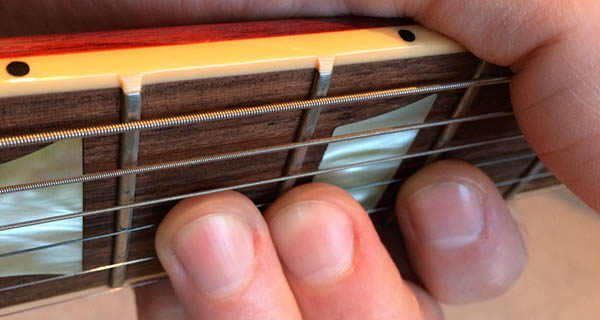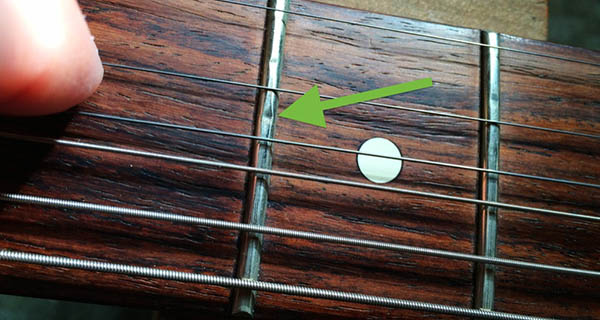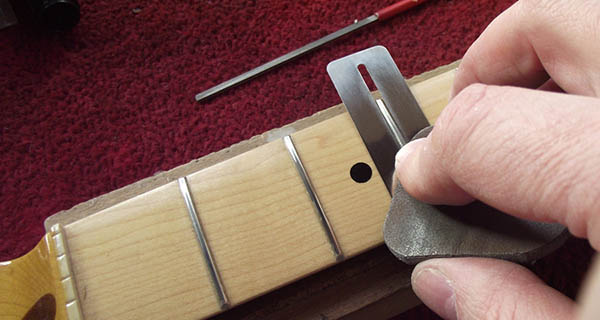Fret Buzz When Releasing String [Reason & Effective Way to Fix]
Fret buzz is a common issue that guitarists encounter, and it can be frustrating to deal with. When releasing strings, the undesirable buzzing sound can affect the overall tone and playability of the guitar. In this guideline, we will delve into the causes of fret buzz when releasing string and explore various prevention and troubleshooting techniques to help you overcome this problem.

# Table of Contents =>
- 1 Reason & Fix: Fret Buzz When Releasing String –
- 1.1 B) Causes of Fret Buzz –
- 1.2 i) Action and Neck Relief:
- 1.3 ii) Fret Wear and Leveling:
- 1.4 iii) Nut and Saddle Issues:
- 1.5 iv) Truss Rod Adjustment:
- 1.6 v) String Gauge and Tension:
- 1.7 C) Prevention and Maintenance –
- 1.8 i) Guitar Setup and Maintenance:
- 1.9 ii) Humidity and Temperature Effects:
- 1.10 iii) Understanding Intonation:
- 1.11 D) Diagnosing and Solving Fret Buzz Issues –
- 1.12 i) Locating the Source of Fret Buzz:
- 1.13 ii) DIY Fixes for Fret Buzz:
- 1.14 iii) Advanced Repairs & Professional Help:
- 1.15 Why Fret Buzz After Changing Strings?
- 1.16 Old Strings Cause Fret Buzz:
A) Understanding Fret Buzz –
What is Fret Buzz?
Fret buzz occurs when a vibrating guitar string comes into contact with one or more frets during play, resulting in an unwanted buzzing or rattling sound. This phenomenon is usually more noticeable when releasing strings after fretting a note. It can be caused by several factors, including improper setup, worn frets, or changes in environmental conditions.
The buzzing sound of fret buzz can vary depending on the location and severity of the issue. Understanding the concept of fret buzz is essential in effectively addressing and resolving the problem.
Types of Fret Buzz:
Fret buzz can manifest in different ways, and it’s crucial to distinguish between the types of buzz to identify the root cause. Some common types of fret buzz include:
High vs Low Action Buzz:
Buzzing can occur with both high and low string action, but the causes are different for each. High action buzz is often due to insufficient relief in the guitar’s neck or uneven frets, while low action buzz can result from the strings coming too close to the frets.
Open String Buzz vs Fretted Note Buzz:
Open string buzz happens when the strings vibrate against a fret while played without any finger on the fretboard. Fretted note buzz occurs when the buzzing sound is heard while fretting a note on the fingerboard.
Reason & Fix: Fret Buzz When Releasing String –
B) Causes of Fret Buzz –
i) Action and Neck Relief:

The action of a guitar refers to the height of the strings above the fretboard. Incorrect action can cause fret buzz, as strings may come into contact with the frets, resulting in buzzing sounds. Neck relief, or the slight curvature of the guitar’s neck, also plays a crucial role in fret buzz. Too much or too little neck relief can lead to buzzing issues.
ii) Fret Wear and Leveling:

Frets can wear down over time due to constant use, leading to uneven fret heights and fret buzz. Fret leveling is a process in which a skilled technician evens out the frets to eliminate buzzing and improve playability.
iii) Nut and Saddle Issues:

The nut and saddle are essential components that help maintain the proper spacing and height of the strings. Problems with the nut, such as incorrect slot depths or sharp edges, can cause buzzing. Similarly, an improperly set saddle height can contribute to fret buzz.
iv) Truss Rod Adjustment:

The truss rod is a metal rod running inside the neck of the guitar, responsible for counteracting the tension of the strings and maintaining the neck’s proper curvature. Adjusting the truss rod can help correct neck relief issues and combat fret buzz.
v) String Gauge and Tension:

The thickness (gauge) and tension of the strings can affect the occurrence of fret buzz. Heavier strings under higher tension may cause more buzzing, while lighter strings might lead to less tension and buzzing.
C) Prevention and Maintenance –
i) Guitar Setup and Maintenance:
Preventing fret buzz starts with proper guitar setup and regular maintenance. This involves adjusting the action, setting the right neck relief, and ensuring the nut and saddle are correctly positioned. Regular cleaning and conditioning of the fretboard and frets are also essential in maintaining a buzz-free guitar.
ii) Humidity and Temperature Effects:

Environmental conditions can impact the playability of a guitar. Changes in humidity and temperature can cause the neck to warp or bow, leading to fret buzz. It’s essential to store the guitar properly and use a humidifier if necessary to maintain stable conditions.
iii) Understanding Intonation:
Intonation refers to the accuracy of the guitar’s tuning across the entire fretboard. Poor intonation can contribute to fret buzz, especially when playing higher up the neck. Adjusting the intonation can help minimize this issue.
D) Diagnosing and Solving Fret Buzz Issues –
i) Locating the Source of Fret Buzz:

Identifying the source of fret buzz is crucial in finding the right solution. By using various techniques and tools, such as fret rocker or feeler gauges, you can pinpoint the areas causing the buzzing sounds.
ii) DIY Fixes for Fret Buzz:
For minor and temporary fret buzz, there are some DIY fixes you can try at home. These may include adjusting the string height at the bridge or nut, applying graphite to the nut slots, or addressing minor fret wear.
iii) Advanced Repairs & Professional Help:

For more severe or persistent fret buzz issues, it’s best to seek assistance from a professional guitar technician. They can perform advanced repairs such as fret dressing, fret replacement, or nut and saddle adjustments to resolve the problem effectively.
Why Fret Buzz After Changing Strings?
After changing strings on a guitar, fret buzz can sometimes become an unexpected annoyance. This occurrence is not uncommon and can be attributed to various factors. One possible reason for fret buzz after a string change is the change in string tension and gauge. Different strings may exert varying amounts of tension on the guitar’s neck, leading to a temporary shift in the instrument’s setup.
The new strings may settle and stretch during the initial period of use, causing fluctuations in the action and intonation. In such cases, the fret buzz is often a transient issue that can be resolved through regular playing and minor adjustments to the guitar’s setup.
Old Strings Cause Fret Buzz:
Yes, old strings can cause fret buzz on a guitar. As strings age, they accumulate dirt, sweat, and debris from regular use, leading to a buildup of grime on the string surfaces. This buildup can cause the strings to lose their clarity and resonance, affecting their ability to vibrate freely. Worn-out strings may lose tension and become slacker, resulting in a lower string height or action. When the action is too low, the strings are more likely to make contact with the frets during vibration, causing fret buzz.
Furthermore, as the metal in old strings wears down, their intonation may become compromised, leading to buzzing sounds when playing certain notes or chords. Replacing old strings with fresh ones is often a straightforward solution to eliminate fret buzz and restore the guitar’s playability and tone.
In the end, fret buzz when releasing string can be a frustrating problem for guitarists, but with a deeper understanding of its causes and appropriate maintenance techniques, you can keep your instrument in optimal condition. Regular guitar setup, careful maintenance, and addressing any issues promptly can help you minimize fret buzz and enjoy a buzz-free playing experience.
Remember that seeking professional help is always a viable option when dealing with complex or persistent buzzing problems. Keeps your guitar well-maintained and happy playing.
Last Updated on August 19, 2023 by Perry Garner
![Using 80 Ohm Headphones Without an Amp [Solved]](https://guitarinsighter.com/wp-content/themes/schema-lite/images/nothumb-related.png)

